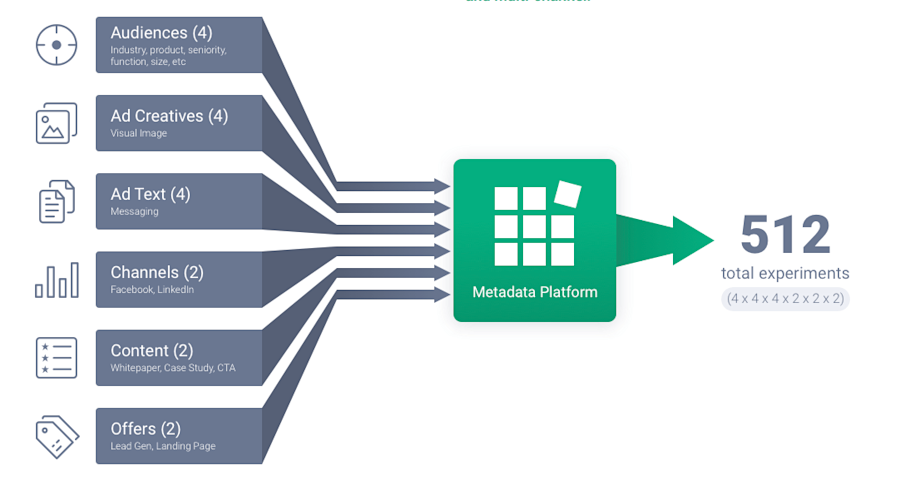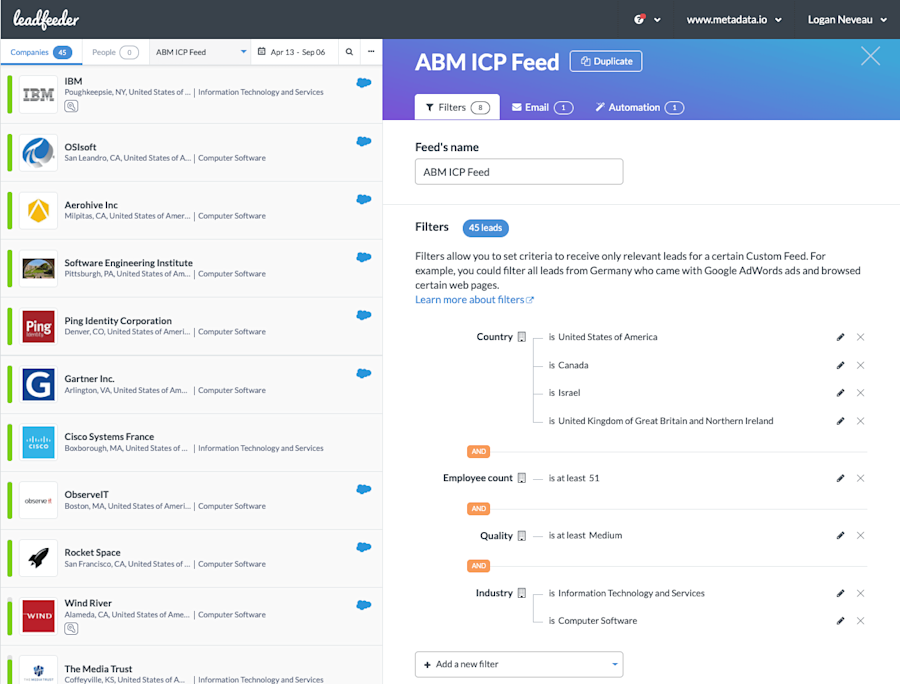Much like the value it offers its customers, Metadata is a lean, mean operating SaaS machine. But let’s backup a second.
What is Metadata’s value propostion?
“With Metadata, one marketer can run thousands of campaigns in a matter of hours while testing the entire mix of content (e.g. whitepaper, eBooks), creatives, ad copy and different channel and campaign types. Without Metadata, this process could take months, followed by the even more time-consuming optimization process.”

So, for sure, at Metadata, they practice what they preach because Logan Neveau, Director of Growth, is steering the marketing helm using a smart blend of tools and, most importantly, by bridging the gap between marketing and the sales team. A little trend we’re noticing—let’s call it the mar-sales approach.
“Leadfeeder helps us to serve ads to targeted companies, making our ABM [account-based marketing] process smoother and more time-efficient,” explains Neveau in a series of interviews with our customer success team.
What is Metadata’s mission?
Metadata’s mission is to “dramatically cut manual labor, improve ad spend efficacy, and automatically eliminate non-performing ad combinations, while funneling more ad spend to placement combinations that generate the most sales pipeline and target account penetration.”
But internally, Metadata’s mission is to increase ROI using Leadfeeder on 30% of its customer accounts for tracking, upselling and management. Combining Leadfeeder with Hubspot Marketing, Salesforce and Outreach.io, Metadata has crafted a simplified, agile, account-based driven process that any growth marketer can mimic and benefit from.
How Metadata Powers Its ABM Strategy With Leadfeeder
For Metadata, Leadfeeder takes a few crucial, time-saving steps out of the equation. On a small scale, they no longer have a need to constantly adjust and closely manage their Google Analytics campaigns associated with their ad traffic. Neveau setup custom feeds with appropriate filters in Leadfeeder for tracking the targeted companies on their website, giving him a quick-glance update whenever he logs-in.

“The big value with Leadfeeder, is understanding which targeted accounts have come to our website and what pages they’ve looked at before we’ve even begun an engagement with them,” Neveau notes. “So let’s say I noticed a particular account was on our website, and they were looking at our pricing page and some deep-funnel content, and we’re not actively engaged in a sales conversation with them—we get one started as soon as possible.”
Food for Thought…
One of the most popular questions we get from sales teams using Leadfeeder for prospecting is: ‘How do I email people and not seem creepy?’
Metadata’s Approach:
“We’ve A/B tested the two different approaches, and I really haven’t seen a staggering difference between, ‘Hey, I saw you were interested in XYZ, or you’re looking at tools and maybe I can help further,’ versus, ‘Hey, I saw you were on our website looking at these specific domains.’ There’s not a big difference in response rates between the two. So, the bump is a soft metric because we can personalize the approach based on network connections (see use case for email alerts above). But for those accounts that we don’t have a personal connection to, our lead to opportunity conversion rate is 1.55X higher than our average.”
Neveau describes the sales team as small, but efficient. The sales setup is basically an email notification to the sales team member from Leadfeeder, manual outreach, intent-focused communications. No regions assigned or round-robin, yet. The sales team prefers twice-daily email alerts for their workflow.
“We work out of leads and opportunities. So getting notifications that an account is interested is a little bit anti to our workflow and it’s just our processes. I totally could set up the notifications, but I don’t know that the account ownership is 100% correct. Whereas, with Leadfeeder and Salesforce working together, I know what the lead and the opportunity ownership is.”
Logan describes sales as a “team sport” and Leadfeeder’s daily email also gives Metadata’s sales team the visibility it needs to close deals as a unit.
For example, use case… “We send the email alert to the entire sales, marketing and senior leadership team. If someone sees a logo they have a connection with, we have a better chance of securing a meeting and winning the deal. That wouldn’t be possible without Leadfeeder’s early warning,” Logan explains.
In the future, as Metadata scales, and their sales team grows, they will begin to implement an advanced account-based marketing and sales program using Leadfeeder’s Imported List feature. Targeting companies becomes a snap as users can now upload CSV files directly into Leadfeeder and begin tracking the leads wanted, and nothing more.
Account-Based Marketing. Simplified.
Struggling to connect the dots between your ABM campaigns and revenue? Or maybe just trying to launch your first ABM program? It doesn’t have to be that difficult.
Identify new accounts, know when target accounts visit your site, and enrich advertising campaigns with website visitor data.
Show me how




